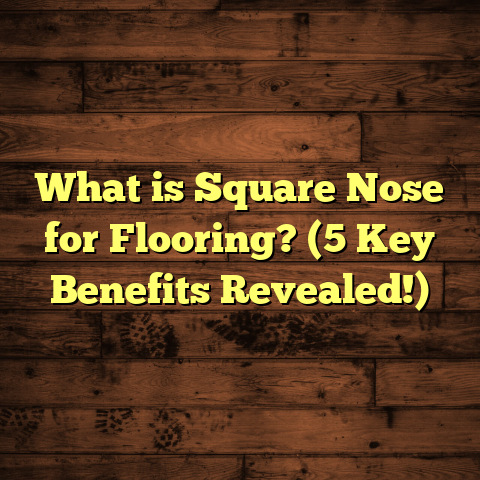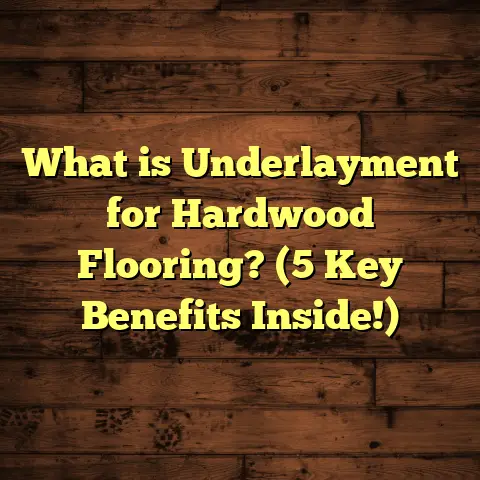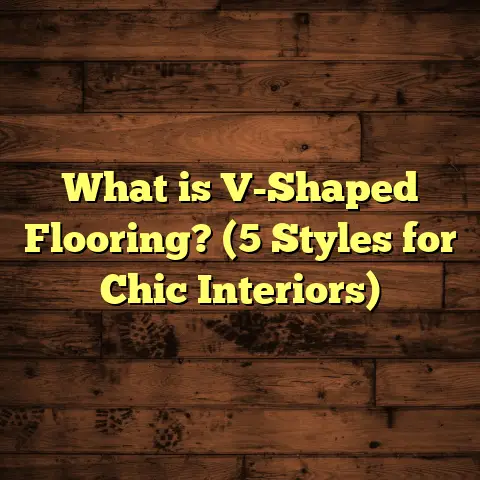What is High-End Wood Flooring? (5 Luxurious Options Explained)
“Wood flooring is not just a surface; it’s a story beneath your feet.
Ever wondered what really makes wood flooring high-end? I’ve been in the flooring world for quite some time, and I can tell you it’s about more than just picking any hardwood. High-end wood flooring is a combination of superior materials, expert craftsmanship, and that undeniable wow-factor that transforms a room into something special.
A story of nature, craftsmanship, and timeless beauty.” — Mark Johnson, Flooring ExpertAt its core, high-end wood flooring refers to wood floors made from rare or premium species, crafted with precision, and finished to perfection. These floors are not only durable but also bring a richness and depth of character that cheaper alternatives can’t match.
Think of it as the difference between a fast-food burger and a gourmet meal prepared by a top chef. Both fill you up, but one leaves you savoring every bite.
To really understand why high-end wood flooring holds such a place in home design, we have to look at what the term encompasses:
- Material: The wood species chosen matters hugely. Exotic woods or select domestic species with unique grain patterns and colors are used.
- Production: How the planks are milled and finished can make or break the floor’s appearance and durability.
- Installation: Professional installation with precision ensures the floor lasts decades without problems.
- Maintenance: High-end floors often require care routines that keep them looking their best.
Over the years, I’ve seen so many floors that looked amazing right after installation but faded quickly because of improper materials or poor installation. High-end wood flooring avoids these issues by focusing on quality at every stage.
My Journey Into High-End Wood Flooring
When I started working in flooring, I thought all hardwood floors were basically the same — just wood on the floor, right? Boy, was I wrong. Early on, I had a project where the client wanted something special for their new home. They asked for something “luxurious yet durable.”
I suggested Brazilian cherry. They were a bit hesitant because it was pricier than typical oak. But once we installed it, the transformation was incredible. The floor had this rich reddish glow that seemed to invite you in. Over time, as it aged gracefully, it became even more beautiful.
Seeing how much joy that floor brought to my client made me realize why people choose high-end wood flooring — it’s about creating spaces that feel alive and welcoming.
Since then, I’ve worked on countless projects installing high-end woods in all types of homes — from rustic cabins to sleek modern condos. Each time, I learn something new about how wood interacts with light, wear, and even emotion.
What Makes High-End Wood Flooring So Special?
You might think all hardwood floors are pretty much the same — just planks nailed down with some finish on top. But there’s actually a world of difference when you go high-end.
Here’s what sets these floors apart:
1. Premium Species
High-end floors often use rare or slow-growing trees that have unique grain patterns and colors you won’t find in mass-market options.
For example:
- Brazilian cherry (Jatoba) has deep reds and browns.
- Walnut offers rich chocolate tones.
- Teak provides natural oils that resist moisture.
- Hickory has bold contrasting colors.
These woods don’t just look good; their density often makes them harder and longer-lasting.
2. Precision Craftsmanship
The milling process for high-end flooring is meticulous:
- Boards are cut to exact thicknesses.
- Edges are beveled or square-cut depending on style.
- Planks are sorted to ensure consistent grain flow or intentional variation.
- Hand-sanding and finishing create smooth surfaces with a natural feel.
I always tell clients that a great floor is like a well-tailored suit — it fits perfectly and feels comfortable.
3. Superior Finishes
High-end wood floors use finishes that enhance natural color while providing tough protection:
- Oil-based polyurethane for deep gloss and durability
- Hardwax oils for natural matte looks
- Aluminum oxide coatings for scratch resistance
These finishes can be applied in multiple layers with hand buffing between coats — something you won’t see in cheaper floors.
4. Installation Expertise
Even the best wood can look bad if installed poorly. High-end installations involve:
- Preparing subfloors meticulously to avoid squeaks or warping
- Using appropriate adhesives or fasteners based on wood type
- Aligning boards carefully for seamless patterns
- Allowing for expansion gaps for seasonal movement
I’ve fixed many floors ruined by rushed or inexperienced installers — trust me, it pays to hire pros.
5. Longevity and Value
A high-end wood floor isn’t just beautiful now; it keeps its charm for decades.
Studies show homes with quality hardwood floors sell faster and at higher prices than those with carpets or laminate.
One report found hardwood floors add an average of 2-3% to home resale value. Over 20-30 years, that’s significant.
5 Luxurious Wood Flooring Options You’ll Love
Now let’s get into the good stuff — actual wood species I recommend based on experience and data.
1. Brazilian Cherry (Jatoba)
Brazilian cherry stands out because it combines beauty and strength like few others.
- Janka hardness rating: Around 2,350 (very hard; resists dents)
- Color: Starts medium reddish-brown; darkens over time to rich mahogany
- Grain: Fine grain with occasional streaks
- Durability: Excellent resistance to wear; ideal for busy households
- Maintenance: Occasional refinishing recommended every 7-10 years
When I installed Brazilian cherry in a family home near Seattle, the owners were amazed how well the floor resisted scratches from their dog’s nails. They told me later it still looked vibrant even after years of heavy use.
Brazilian cherry’s popularity has grown because it ages gracefully — developing a deeper patina that many say gives it character.
2. White Oak
White oak is one of the most versatile woods around.
- Janka hardness rating: About 1,360 (hard enough for most uses)
- Color: Light beige to medium brown with subtle golden hues
- Grain: Straight grain with a coarse texture
- Durability: Good moisture resistance compared to red oak
- Sustainability: Often harvested responsibly from US forests
Data from the National Wood Flooring Association shows white oak accounts for nearly 30% of hardwood flooring sales in North America.
I installed white oak floors in a historic farmhouse renovation last year. The homeowners loved how it blended traditional charm with modern durability.
3. Teak
Teak brings natural oils into play, making it perfect for moisture-prone areas like kitchens or sunrooms.
- Janka hardness rating: Approximately 1,070 (moderately hard)
- Color: Golden brown with darker streaks
- Grain: Straight-grain with oily texture
- Durability: Naturally resistant to water, termites, and decay
- Maintenance: Needs oiling periodically to maintain sheen
In coastal homes I’ve worked on near Florida, teak floors have held up beautifully against humidity and salt air — no warping or swelling after years.
Teak’s price tends to be higher due to limited supply but its longevity often offsets initial cost.
4. Hickory
Hickory is rugged, with strong contrasts in color that give rooms personality.
- Janka hardness rating: Around 1,820 (very hard)
- Color: Ranges from creamy white to dark brown within one plank
- Grain: Distinctive swirling grain patterns
- Durability: Excellent shock resistance; great for active households
- Look: Bold appearance that works well in rustic or modern styles
One client had hickory installed in their cabin’s living room — pets and kids put it through the wringer but the floor showed hardly any dents or marks after two years.
Hickory is also one of the more affordable hardwoods among premium options, making it popular for those wanting durability without breaking the bank.
5. Walnut
Walnut is synonymous with luxury — deep colors and smooth textures make it stand out quietly.
- Janka hardness rating: About 1,010 (softer than hickory or cherry)
- Color: Dark chocolate browns with occasional purples or grays
- Grain: Straight grain with fine texture
- Durability: Requires some care due to softer nature but ages beautifully
- Aesthetic: Warmth and richness perfect for formal rooms or offices
Walnut floors often add a sense of elegance without feeling too flashy. I installed walnut in an upscale law office where clients complimented how inviting yet professional the space felt.
Why Do These Woods Cost More?
You may be wondering why these woods carry heftier price tags compared to more common species like red oak or maple.
Here’s what drives costs up:
Cost Factor Explanation Impact Rarity Some trees grow slowly or are harvested less frequently Higher raw material cost Milling & Crafting Extra attention in cutting, drying, and finishing Increased labor costs Durability Dense woods require more processing but last longer Long-term savings Unique Appearance Distinct color/texture demands selection Adds value Certification Sustainability certifications can increase cost Ethical investment It’s worth noting that some exotic woods like Brazilian cherry come mostly from South America where harvesting regulations affect supply and pricing.
How I Help Clients Pick the Perfect Floor
Choosing high-end wood flooring can feel overwhelming because there are so many options—and not all fit every lifestyle or budget.
When clients ask me for advice, I usually start by asking:
- What kind of traffic will your floor see? Kids? Pets?
- What style or color do you prefer? Warm tones? Cool tones?
- How much maintenance are you willing to do?
- Do you want something unique or classic?
For example:
- If durability is key (say kids and pets), I suggest Brazilian cherry or hickory.
- For elegance with moderate use, walnut is beautiful.
- If moisture is an issue (kitchens/bathrooms), teak is a great choice.
- White oak fits almost any style and offers great value.
I also encourage clients to request samples so they can see how light affects color in their own space. Wood changes tone depending on sunlight exposure—something you don’t want to guess blindly!
Installation Costs & Budgeting Your Luxe Floor
High-end means higher price upfront—but how much exactly?
Here’s an overview based on recent projects:
Wood Type Material Cost per Sq Ft Installation Cost per Sq Ft Total Cost per 1,000 Sq Ft Brazilian Cherry $8 – $12 $4 – $7 $12,000 – $19,000 White Oak $6 – $10 $3 – $6 $9,000 – $16,000 Teak $10 – $15 $5 – $8 $15,000 – $23,000 Hickory $7 – $11 $4 – $7 $11,000 – $18,000 Walnut $9 – $14 $4 – $7 $13,000 – $21,000 Keep in mind:
- Installation costs vary by region and complexity.
- Subfloor preparation can add costs if repairs needed.
- Custom patterns (herringbone, chevron) increase labor time.
- Finishing on-site adds labor but lets you tailor sheen/color exactly.
I always advise clients not to cut corners on installation—precision work prevents costly callbacks later.
Maintenance Tips That Keep Floors Looking New
High-end wood floors deserve care so they can shine for decades. Here are my best tips:
Daily & Weekly Care
- Sweep or vacuum regularly using soft brushes to remove dirt.
- Use microfiber dust mops to avoid scratches.
- Avoid wet mops; if needed use damp cloth with pH-neutral cleaner made for wood.
Seasonal Care
- Check humidity levels; ideal range is 35%-55%. Use humidifiers/dehumidifiers as needed.
Annual Care
- Inspect floors for scratches or wear spots.
- Consider applying a fresh coat of wax or polish depending on finish type.
Every Few Years
- Refinishing extends life—sanding off old finish and applying new coats.
One client shared her walnut floors still looked flawless after 10 years just by following these simple steps. It really pays off!
Real Stories From My Work
Here are some stories from clients who chose high-end floors:
The Busy Family With Brazilian Cherry
A Seattle family wanted floors tough enough for kids and dogs but still warm and inviting. We installed Brazilian cherry with a matte finish that hides scratches well.
Three years later? The floors looked stunning despite heavy daily use—a big win for everyone!
The Coastal Home With Teak Floors
In Florida, humidity wrecks many floors quickly. One client chose teak because of its natural oils resisting moisture. It held up perfectly after hurricanes and salt air exposure — no swelling or damage whatsoever.
The Rustic Cabin With Hickory
A mountain cabin owner wanted rustic charm but needed durability for active weekends with kids and pets. Hickory’s bold patterns gave the cabin character while standing up to rough use beautifully.
These stories show how picking right can solve challenges while adding beauty.
Design Ideas Using High-End Wood Flooring
Want your floor to be more than just wood? Here are some creative ideas I’ve helped clients implement:
Mix Wood Species
Combining two types—like white oak borders with walnut center panels—creates unique visual interest without overwhelming the space.
Custom Patterns
Herringbone or chevron patterns add sophistication but require expert installation (expect higher cost).
Wide Planks
Wider boards (6”+) show off grain better and suit spacious rooms well—adds luxury feel instantly.
Matte vs Glossy Finishes
Matte finishes look natural and hide scratches better; glossy finishes reflect light for sleek elegance but show wear faster.
Common Questions People Ask Me About High-End Wood Flooring
Is high-end wood flooring worth the investment?
Absolutely! While initial costs are higher, longevity, beauty, and increased home value make it worthwhile over time.
Can high-end wood flooring be installed over radiant heat?
Yes! Engineered versions of these woods are great over radiant heating systems because they’re stable and resist warping better than solid wood.
How long do these floors last?
With proper care and occasional refinishing? Easily 30+ years; some historic homes have original floors over 100 years old!
Can I install high-end wood flooring myself?
I don’t recommend it unless you’re very experienced — mistakes cost more than hiring pros here.
Wrapping It Up — My Take on High-End Wood Flooring
High-end wood flooring isn’t just about spending money; it’s about investing in beauty that lasts decades while adding real value to your home.
Every type I discussed has its own personality and advantages—whether you want rugged durability or elegant warmth—there’s an option perfect for your lifestyle.
If you’re thinking about upgrading your floors or building a new space, consider these luxurious woods carefully. Having walked this journey many times with clients helps me guide you toward choices you’ll love living with every day.
Have you ever walked on a floor that made you stop and smile? That’s what I want for every client I work with—and trust me: once you experience the warmth and richness of high-end wood flooring yourself, it’s hard to go back!
If you want to chat more about what might work best for your space or need help budgeting your project appropriately, just ask! I’m here to help you make your flooring dreams real.
Learn more





